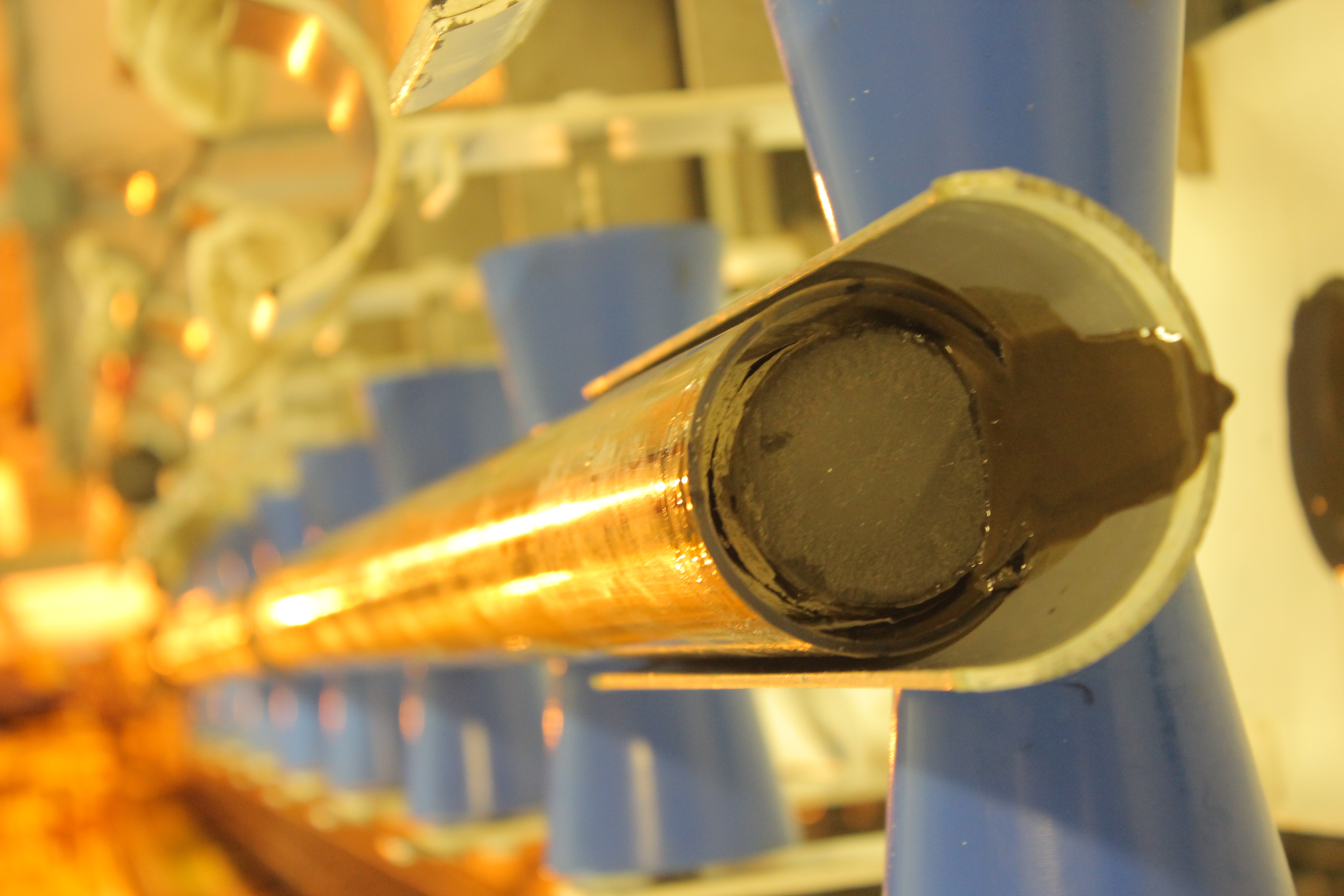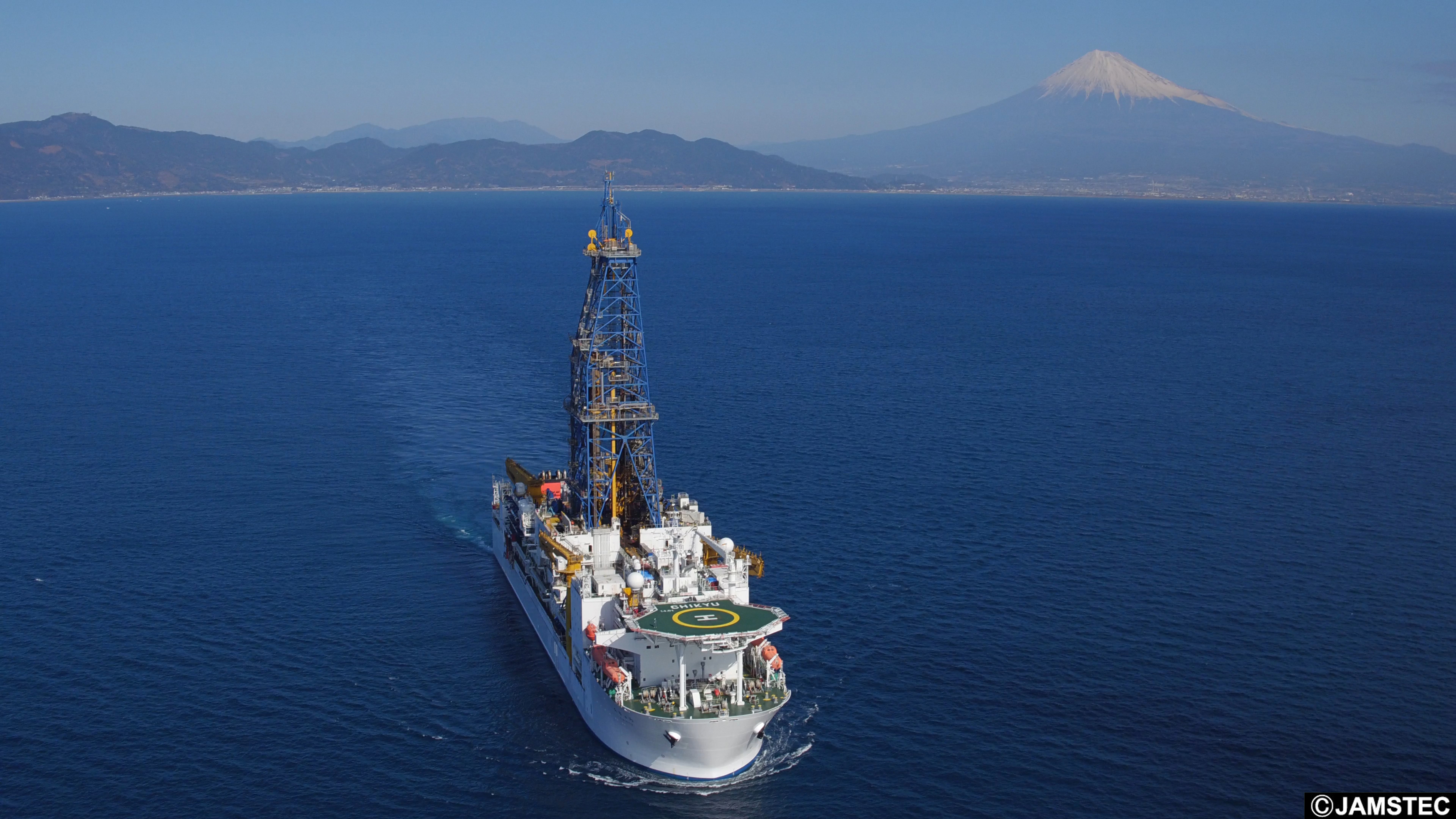Seafloor Drilling Reveals Secrets of the Deep Earth

Scientists with the Deep Carbon Observatory have reported several transformational discoveries, including how much and what kinds of life exist in the deep subsurface under the greatest extremes of pressure, temperature, and low energy and nutrient availability.
Drilling 2.5 kilometers into the seafloor, and sampling microbes from continental mines and boreholes more than 5 km deep, the team has used the results to construct models of the ecosystem deep within the planet.
 The D/V Chikyu is one of the most advanced scientific drilling ships available today. Coring operations take place 24 hours a day. Image courtesy of Luc Riolon/JAMSTEC.
The D/V Chikyu is one of the most advanced scientific drilling ships available today. Coring operations take place 24 hours a day. Image courtesy of Luc Riolon/JAMSTEC.
Barely living “zombie” bacteria and other forms of life constitute an immense amount of carbon deep within Earth’s subsurface—245 to 385 times greater than the carbon mass of all humans on the surface, according to scientists nearing the end of a 10-year international collaboration to reveal Earth’s innermost secrets. With insights from now hundreds of sites under the continents and seas, they have approximated the size of the deep biosphere—2 to 2.3 billion cubic km (almost twice the volume of all oceans)—as well as the carbon mass of deep life: 15 to 23 billion tonnes (an average of at least 7.5 tonnes of carbon per cu km subsurface). The work also helps determine types of extraterrestrial environments that could support life.
 Scientists look for signs of life in cores like this one. The cores on International Ocean Discovery Program's (IODP) Expedition 337 were taken to depths down to 2.5 km below the seafloor, where temperature increases from 30°C to 60°C, spanning the predicted temperature limit for life on Earth. Image courtesy of Luc Riolon/JAMSTEC.
Scientists look for signs of life in cores like this one. The cores on International Ocean Discovery Program's (IODP) Expedition 337 were taken to depths down to 2.5 km below the seafloor, where temperature increases from 30°C to 60°C, spanning the predicted temperature limit for life on Earth. Image courtesy of Luc Riolon/JAMSTEC.
Among many key discoveries and insights:
- The deep biosphere constitutes a world that can be viewed as a sort of “subterranean Galapagos” and includes members of all three domains of life: bacteria, archaea, and eukarya
- Two types of microbes—bacteria and archaea—dominate Deep Earth. Among them are millions of distinct types, most yet to be discovered or characterized. This so-called microbial “dark matter” dramatically expands our perspective on the tree of life. Deep Life scientists say about 70% of Earth's bacteria and archaea live in the subsurface
- Deep microbes are often very different from their surface cousins, with life cycles on near-geologic timescales, dining in some cases on nothing more than energy from rocks
- The genetic diversity of life below the surface is comparable to or exceeds that above the surface
- While subsurface microbial communities differ greatly between environments, certain genera and higher taxonomic groups are ubiquitous - they appear planet-wide
- Microbial community richness relates to the age of marine sediments where cells are found—suggesting that in older sediments, food energy has declined over time, reducing the microbial community
- The absolute limits of life on Earth in terms of temperature, pressure, and energy availability have yet to be found. The records continually get broken. A frontrunner for Earth’s hottest organism in the natural world is Geogemma barossii, a single-celled organism thriving in hydrothermal vents on the seafloor. Its cells, tiny microscopic spheres, grow and replicate at 121 degrees Celsius (21 degrees hotter than the boiling point of water)
- Microbial life can survive up to 122°C, the record achieved in a lab culture (by comparison, the record-holding hottest place on Earth’s surface, in an uninhabited Iranian desert, is about 71°C.
- The record depth at which life has been found in the continental subsurface is approximately 5 km; the record in marine waters is 10.5 km from the ocean surface, a depth of extreme pressure; at 4000 meters depth, for example, the pressure is approximately 400 times greater than at sea level
- Scientists have a better understanding of the impact on life in subsurface locations manipulated by humans (e.g., fracked shales, carbon capture and storage)
 Ever-increasing accuracy and the declining cost of DNA sequencing, coupled with breakthroughs in deep ocean drilling technologies (pioneered on the Japanese scientific vessel Chikyu, designed to ultimately drill far beneath the seabed in some of the planet’s most seismically-active regions) made it possible for researchers to take their first detailed look at the composition of the deep biosphere.
Ever-increasing accuracy and the declining cost of DNA sequencing, coupled with breakthroughs in deep ocean drilling technologies (pioneered on the Japanese scientific vessel Chikyu, designed to ultimately drill far beneath the seabed in some of the planet’s most seismically-active regions) made it possible for researchers to take their first detailed look at the composition of the deep biosphere.
There are comparable efforts to drill ever deeper beneath continental environments, using sampling devices that maintain pressure to preserve microbial life (none thought to pose any threat or benefit to human health).
 To estimate the total mass of Earth’s subcontinental deep life, for example, the team compiled data on cell concentration and microbial diversity from locations around the globe. Led by Cara Magnabosco of the Flatiron Institute Center for Computational Biology, New York, the scientists factored in a suite of considerations, including global heat flow, surface temperature, depth and lithology—the physical characteristics of rocks in each location—to estimate that the continental subsurface hosts 2 to 6 × 1029 cells. Combined with estimates of subsurface life under the oceans, total global Deep Earth biomass is approximately 15 to 23 petagrams (15 to 23 billion tonnes) of carbon.
To estimate the total mass of Earth’s subcontinental deep life, for example, the team compiled data on cell concentration and microbial diversity from locations around the globe. Led by Cara Magnabosco of the Flatiron Institute Center for Computational Biology, New York, the scientists factored in a suite of considerations, including global heat flow, surface temperature, depth and lithology—the physical characteristics of rocks in each location—to estimate that the continental subsurface hosts 2 to 6 × 1029 cells. Combined with estimates of subsurface life under the oceans, total global Deep Earth biomass is approximately 15 to 23 petagrams (15 to 23 billion tonnes) of carbon.
Says Mitch Sogin of the Marine Biological Laboratory Woods Hole, USA, co-chair of DCO’s Deep Life community of more than 300 researchers in 34 countries: “Exploring the deep subsurface is akin to exploring the Amazon rainforest. There is life everywhere, and everywhere there’s an awe-inspiring abundance of unexpected and unusual organisms.
 “Molecular studies raise the likelihood that microbial dark matter is much more diverse than what we currently know it to be, and the deepest branching lineages challenge the three-domain concept introduced by Carl Woese in 1977. Perhaps we are approaching a nexus where the earliest possible branching patterns might be accessible through deep life investigation.”
“Molecular studies raise the likelihood that microbial dark matter is much more diverse than what we currently know it to be, and the deepest branching lineages challenge the three-domain concept introduced by Carl Woese in 1977. Perhaps we are approaching a nexus where the earliest possible branching patterns might be accessible through deep life investigation.”
“Ten years ago, we knew far less about the physiologies of the bacteria and microbes that dominate the subsurface biosphere,” says Karen Lloyd, University of Tennessee at Knoxville, USA. “Today, we know that, in many places, they invest most of their energy to simply maintaining their existence and little into growth, which is a fascinating way to live.
“Today too, we know that subsurface life is common. Ten years ago, we had sampled only a few sites—the kinds of places we'd expect to find life. Now, thanks to ultra-deep sampling, we know we can find them pretty much everywhere, albeit the sampling has obviously reached only an infinitesimally tiny part of the deep biosphere.”

